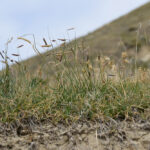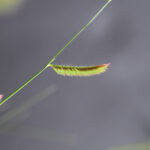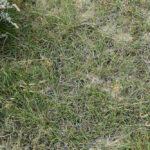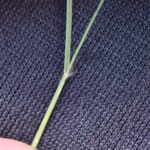Blue Grama
Bouteloua gracilis
General Description
Blue grama is short growing with smooth flat or loosely curled/twisted leaves. Leaves on average 5-10 cm (2-4 in) long. Seed heads are curved and resemble an eyelash. Blue grama is a bunchgrass that tillers to form a sod mat with shallow roots.
Type
Native grass.
Origin
Mixed grass prairie.
Longevity
Long-lived.
Use
Reclamation, pasture.
Optimal Time of Use
Summer, fall. Blue grama is a “warm season (C4) grass” and grows primarily during mid to late summer. A pure stand of blue grama is best grazed summer or fall. When blue grama is seeded in a mix, time grazing for the other species in the mix.
Recovery After Use
Blue grama takes approximately fourteen months to fully recover from grazing.
Palatability/Nutritional Value
Blue grama has a peak digestibility of 50% in July and lows of 40% in October. Crude protein levels range from 5-9%.
Annual Precipitation min/max (mm)
200mm / 560mm
Drought Tolerance
Very drought tolerant.
Flooding Tolerance
Tolerates approximately one week of saturated soils in the spring.
Winter Hardiness
High winter hardiness.
Soil Texture Preference
Blue grama is suited to well drained sandy to clay soils in the Brown and Dark Brown soil zones. Blue grama is found in native pastures on well drained and dry soils on hillsides and hill tops and south facing slopes.
Erosion Control
Blue grama is best used in mixes with other native grasses for erosion control. It stabilizes soil by forming a thick, sod.
Salinity Tolerance
Low salinity tolerance.
Acidity Tolerance
Slight tolerance.
Alkalinity Tolerance
Moderate tolerance.
Seeds per kg
1,596,000 seeds/kg (724,400 seeds/lb)
Suggested Mixtures
Blue grama may be mixed with native species in a pasture or reclamation mix. It is one of the few warm season grasses with broad adaptation for the prairies.
Ease of Establishment
Blue grama is slow to establish. Seeds are very small and seedlings are delicate.
Competitiveness
Once established, blue grama forms a thick sod that is not easily invaded by other plants and increases in overgrazed pastures.
Management Considerations
Allow for adequate rest following defoliation.
AESB Native Manual, Seeding Natives (Sask AG/GAPT), Saskatchewan Dryland Forage Species Adaptation Tool



